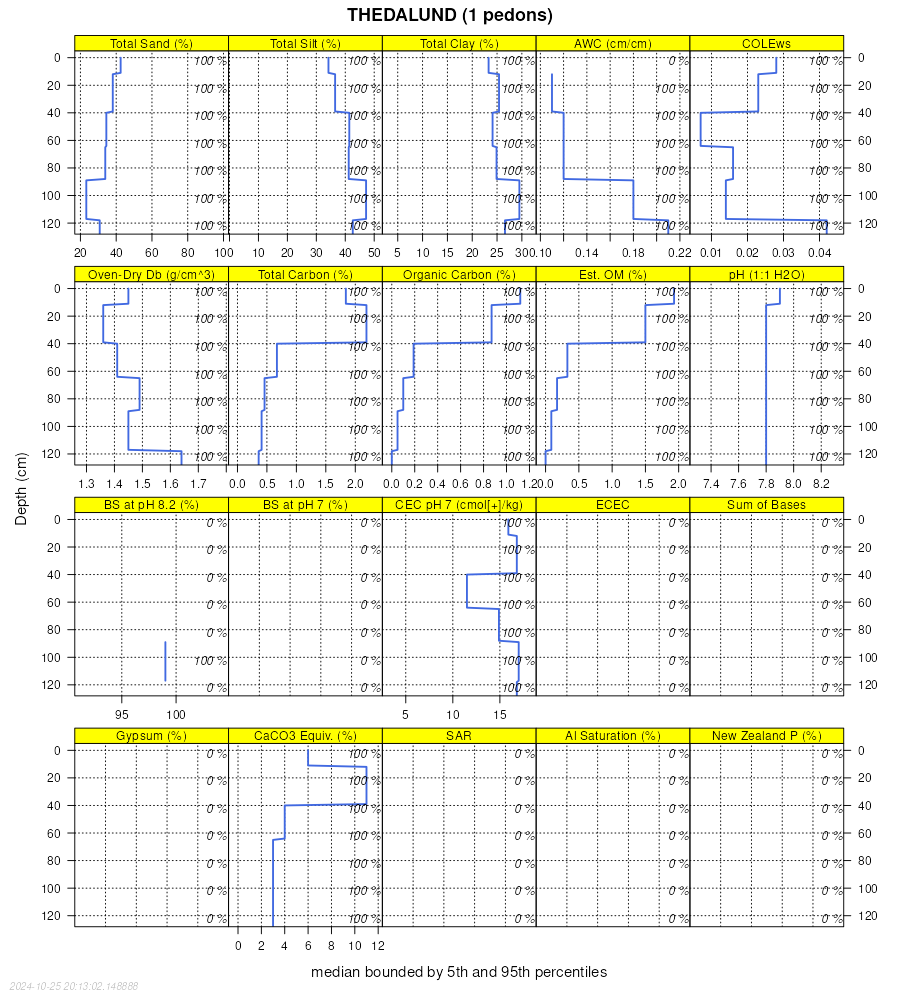| Terry-Olney-Thedalund sandy loams, 5 to 20 percent slopes | TeE | 20534 | 94164 | 34zk | co005 | 1971 | 1:20000 |
Renohill-Litle-Thedalund complex, 9 to 30 percent slopes | RtE | 15632 | 94151 | 34z4 | co005 | 1971 | 1:20000 |
Baca-Thedalund loams, 3 to 9 percent slopes | BhD | 8846 | 94110 | 34xt | co005 | 1971 | 1:20000 |
Thedalund clay loam, 9 to 20 percent slopes | ThE | 3228 | 94165 | 34zl | co005 | 1971 | 1:20000 |
Thedalund clay loam, 9 to 20 percent slopes, eroded | ThE2 | 1590 | 94166 | 34zm | co005 | 1971 | 1:20000 |
Thedalund silty clay loam | Th | 910 | 94214 | 3515 | co009 | 1966 | 1:20000 |
Thedalund-Kim-Shingle complex, 9 to 20 percent slopes | 109 | 9067 | 94470 | 359f | co075 | 1974 | 1:24000 |
Thedalund-Keota loams, 3 to 9 percent slopes | 67 | 4417 | 95162 | 360r | co617 | 1980 | 1:24000 |
Thedalund-Keota loams, 0 to 3 percent slopes | 66 | 2149 | 95161 | 360q | co617 | 1980 | 1:24000 |
Thedalund loam, 1 to 3 percent slopes | 64 | 7628 | 95246 | 363g | co618 | 1976 | 1:24000 |
Thedalund loam, 3 to 9 percent slopes | 65 | 3505 | 95247 | 363h | co618 | 1976 | 1:24000 |
Kim-Thedalund loams, 3 to 15 percent slopes | 56 | 4659 | 497705 | jpx0 | co644 | 1980 | 1:24000 |
Thedalund loam, 3 to 9 percent slopes | 108 | 3439 | 497644 | jpv1 | co644 | 1980 | 1:24000 |
Thedalund loam, 0 to 3 percent slopes | 107 | 591 | 497643 | jpv0 | co644 | 1980 | 1:24000 |
Midway-Thedalund complex, hilly | MVf | 121951 | 346067 | cm3g | mt607 | 1970 | 1:24000 |
Thedalund-Rock outcrop complex, hilly | THg | 52566 | 346179 | cm72 | mt607 | 1970 | 1:24000 |
Thedalund-Wibaux stony loams, hilly | THn | 47033 | 346184 | cm77 | mt607 | 1970 | 1:24000 |
Thedalund-Midway complex, rolling | THe | 37944 | 346177 | cm70 | mt607 | 1970 | 1:24000 |
Thedalund-Fort Collins complex, rolling | THc | 36043 | 346175 | cm6y | mt607 | 1970 | 1:24000 |
Midway-Thedalund complex, rolling | MVe | 35130 | 346066 | cm3f | mt607 | 1970 | 1:24000 |
Thedalund-Clapper complex, hilly | THa | 26528 | 346173 | cm6w | mt607 | 1970 | 1:24000 |
Thedalund-McRae loams, dissected | THd | 14257 | 346176 | cm6z | mt607 | 1970 | 1:24000 |
Thedalund-Wibaux complex, very steep | THo | 13437 | 346185 | cm78 | mt607 | 1970 | 1:24000 |
Thedalund-Wibaux complex, rolling | THm | 13334 | 346183 | cm76 | mt607 | 1970 | 1:24000 |
Travessilla-Thedalund loams, rolling | TS | 9892 | 346187 | cm7b | mt607 | 1970 | 1:24000 |
Thedalund-Nelson complex, rolling | THf | 6700 | 346178 | cm71 | mt607 | 1970 | 1:24000 |
Thedalund loam, undulating | Tg | 5890 | 346193 | cm7j | mt607 | 1970 | 1:24000 |
Thedalund-Rock outcrop complex, very steep | THh | 5207 | 346180 | cm73 | mt607 | 1970 | 1:24000 |
Thedalund-Travessilla loams, rolling | THk | 4800 | 346181 | cm74 | mt607 | 1970 | 1:24000 |
Thedalund-Cushman loams, undulating | THb | 4714 | 346174 | cm6x | mt607 | 1970 | 1:24000 |
Thedalund-Wibaux loams, undulating | THl | 1712 | 346182 | cm75 | mt607 | 1970 | 1:24000 |
Thedalund clay loam, 4 to 8 percent slopes | Te | 2120 | 347157 | cn7m | mt611 | 1971 | 1:24000 |
Thedalund clay loam, 8 to 15 percent slopes | Tf | 1781 | 347158 | cn7n | mt611 | 1971 | 1:24000 |
Razor-Thedalund clay loams, 4 to 15 percent slopes | Rb | 1343 | 347119 | cn6d | mt611 | 1971 | 1:24000 |
Cheeta-Rock outcrop-Thedalund complex, 10 to 60 percent slopes, extremely stony | AMG | 15117 | 2398205 | 2lhjg | ut013 | | 1:24000 |
Thedalund family, moist | 72 | 63338 | 504570 | jy1g | ut624 | 1985 | 1:24000 |
Thedalund family, stony | 73 | 37170 | 504571 | jy1h | ut624 | 1985 | 1:24000 |
Mesa-Chipeta-Thedalund family complex | 31 | 29052 | 504525 | jy00 | ut624 | 1985 | 1:24000 |
Thedalund family-Rock outcrop-Badland association | 74 | 17112 | 504572 | jy1j | ut624 | 1985 | 1:24000 |
Thedalund family, cool | 71 | 1257 | 504569 | jy1f | ut624 | 1985 | 1:24000 |
Sandoval-Thedalund family complex | 59 | 1107 | 504555 | jy0z | ut624 | 1985 | 1:24000 |
Kim-Zigweid loams, 3 to 10 percent slopes | 90 | 2435 | 349370 | cqk0 | wy011 | 1978 | 1:24000 |
Thedalund loam, 6 to 10 percent slopes | 184 | 1417 | 349269 | cqfr | wy011 | 1978 | 1:24000 |
Alice-Thedalund complex, 3 to 10 percent slopes | 13 | 529 | 349209 | 30wnq | wy011 | 1978 | 1:24000 |
Alice-Thedalund complex, 10 to 30 percent slopes | 14 | 111 | 349220 | cqd5 | wy011 | 1978 | 1:24000 |
Shingle-Thedalund loams, 3 to 45 percent slopes -- Draft | 490 | 521 | 152237 | 53dw | wy603 | | 1:24000 |
Thedalund clay loam, 0 to 3 percent slopes -- Draft | 50A | 6361 | 152593 | 53sc | wy629 | | 1:24000 |
Shingle-Thedalund-Midway complex, 0 to 35 percent slopes -- Draft | 350 | 460 | 152526 | 53q6 | wy629 | | 1:24000 |















